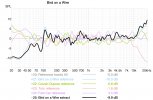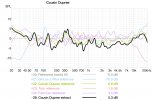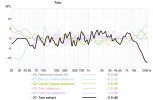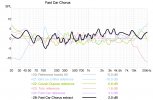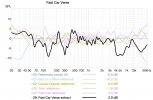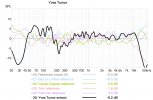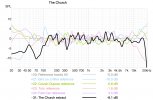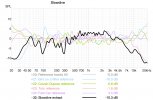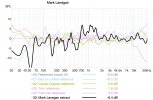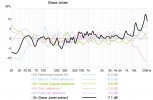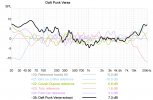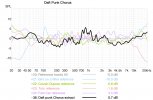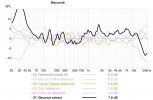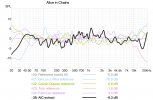I have occasionally been using the website FunkyABX as a way to upload and compare a number of EQed files for my own use, and as I had prepared a number of files with some of the newer 5128 / type 4.3 ear simulator targets Harman recently tested (discussion in this thread), I thought that perhaps it could be interesting to share them.
I'd like to mention first and foremost that I don't consider this a properly controlled and designed test, for reasons developed below, but it could still prove useful to some of you to some capacity.
To perform these listening tests, you will need a pair of Truthear Zero Red, as the files are EQed assuming that these will be used as the reproduction device.
In addition :
Below is a set of links to each test. The targets have been anonymized and given a letter designation (A, B, C, D, E and F) valid across all tests. The tracks noted as “recommended” were used in Harman’s listening tests (but perhaps not the same extract or master).
This WE I’ll provide another link to another test where the targets will be revealed by associating each letter with a label. My advice would be to have performed the test for at least some or all the tracks below by then - but don't feel pressured into taking them all !
Jennifer Warnes - Bird on a Wire (recommended)
Tracy Chapman - Fast Car - Chorus (recommended)
Tracy Chapman - Fast Car - Verse (recommended)
Steely Dan - Cousin Dupree (recommended)
Toto - I Will Remember (recommended)
Alice in Chains - No Excuses - MTV Unplugged (optional)
Daft Punk - Get Lucky - Verse (optional)
Daft Punk - Get Lucky - Chorus (optional)
The Church - Aura (optional)
Grace Jones - Slave to the Rhythm - Ladies and Gentlemen (optional)
Beyoncé - America has a Problem - Single (optional)
Mark Lanegan - Riding the Nightingale (optional)
Yves Tumor - Lovely Sewer (optional)
Slowdive - Star Roving (optional)
Some notes on the EQ process methodology :


Some notes on the choice of the Truthear Zero Red :
This isn't an ideal choice, far from it. But I can't think of much better alternatives across the board either. If I were to list the positive and negative aspects of that selection, this is what I'd suggest (feel free to complete that list) :
Negatives :
 .
.
I’m open to try this with another IEM if you can suggest one that features all of the pluses above and solves the minuses (in particular the fit issues). But most of the usual suspects you can think of, I've probably thought about them too, and have some issues with as well !
Some notes on the listening test format and some suggestions on the questions and conclusions you can and can't draw from it :
I think that it’s important to emphasise that this is not a properly controlled and designed listening test to provide overall data worth analysing. As a consequence I’ve disabled the capability to see the average results as I don’t think that it would lead to particularly fruitful conversations. Think of it rather as a way to provide potentially useful information for you in regards to your preferences (if you own a pair of these IEMs, can it help in steering you towards an EQ profile that will be preferred ?), or more generally a better understanding of what it means to have to express preferences among such close targets when having to deal with other variables (such as program material).
The test format does not adhere to good MUSHRA practices (but should it exactly ? I have some questions on the proper use of anchors for a test such as this one) and I don't think that the rating scale is quite appropriate. There's an API called webMUSHRA that I think could be more appropriate to use but I have no idea how to do so.
I would advise against considering it a blind test. It certainly isn’t for me as I applied the EQ profiles in the first place and can recognise them anyway most of the time, but you must certainly come in knowing how some of these targets, some of which you’ve probably already EQed some of your IEMs to, tend to sound relative to each others.
And I would also be careful about over-interpreting the results you’d get. Among other factors, whether it’s because of sample variation, leakage, varying ear canal length and volume or varying eardrum impedance, the in situ frequency response is uncontrolled. Besides, IEMs may not transfer in a similar way between an ear simulator and your own ears, so what you can take away by EQing your own sample of the Truthear Zero Red to one of these targets may not perfectly translate to other IEMs.
The questions that I think could be more interesting are :
I'd like to mention first and foremost that I don't consider this a properly controlled and designed test, for reasons developed below, but it could still prove useful to some of you to some capacity.
To perform these listening tests, you will need a pair of Truthear Zero Red, as the files are EQed assuming that these will be used as the reproduction device.
In addition :
- If they fit you well, please try to use the narrow bore tips they were provided with.
- No EQ.
- No impedance adapter.
- Plug them into a source with a known output impedance of less than 1ohm.
- Do not take this test by EQing another pair of headphones to the Truthear Red Zero.
Below is a set of links to each test. The targets have been anonymized and given a letter designation (A, B, C, D, E and F) valid across all tests. The tracks noted as “recommended” were used in Harman’s listening tests (but perhaps not the same extract or master).
This WE I’ll provide another link to another test where the targets will be revealed by associating each letter with a label. My advice would be to have performed the test for at least some or all the tracks below by then - but don't feel pressured into taking them all !
Jennifer Warnes - Bird on a Wire (recommended)
Tracy Chapman - Fast Car - Chorus (recommended)
Tracy Chapman - Fast Car - Verse (recommended)
Steely Dan - Cousin Dupree (recommended)
Toto - I Will Remember (recommended)
Alice in Chains - No Excuses - MTV Unplugged (optional)
Daft Punk - Get Lucky - Verse (optional)
Daft Punk - Get Lucky - Chorus (optional)
The Church - Aura (optional)
Grace Jones - Slave to the Rhythm - Ladies and Gentlemen (optional)
Beyoncé - America has a Problem - Single (optional)
Mark Lanegan - Riding the Nightingale (optional)
Yves Tumor - Lovely Sewer (optional)
Slowdive - Star Roving (optional)
Some notes on the EQ process methodology :
- The frequency response of the Truthear Zero Red was obtained by averaging data from several samples. As the 5128 fixture is quite susceptible to produce rocking modes at low frequencies, that may quite likely not be present in people’s ears in most cases, the average that was obtained has been first modified around 100-500Hz to compare it more easily with smoother targets in that region. These modifications were done as seen in the graph here, based on my own experience controlling for it in other test fixtures and other data points. This is to some extent an arbitrary process. I wish some more work had been done already to try to solve this problem, but in the meantime this approach will have to make do.
- Equalisation was rather strictly applied up to around 8kHz, with some attempts at maintaining a close fit to the target up to around 10kHz. Above that a shelf was used to bring the level visually in line with the average. This is not what most would recommend how you should EQ your own sample to a particular target for your own use, but this is closer to the method Harman typically uses.
- A theoretical EQ profile was designed in Room EQ Wizard and then converted to be applied using AUNBandEQ (IIR filters) with Audacity. As there may be some slight variations between how different EQ plugins actually apply the filters, particularly at higher frequencies, an extra filter was added in AUNBandEQ to compensate for any discrepancy that was found (for two targets). The spectrum of the tracks was analysed after applying EQ to make sure that the profile was properly applied. The files were then normalised for loudness according to EBU R128.
- If applicable, the targets were directly digitised after Sean Olive’s latest presentation at Canjam NYC 2024. There were some minor discrepancies between different sources, but I thought that this could be closer to what was tested. A somewhat arbitrary choice had to be made in regard to one target in particular, and it could be interesting to discuss it later on - there are good reasons why I chose it instead of the alternative
.
Some notes on the choice of the Truthear Zero Red :
This isn't an ideal choice, far from it. But I can't think of much better alternatives across the board either. If I were to list the positive and negative aspects of that selection, this is what I'd suggest (feel free to complete that list) :
Negatives :
- A poor fit for quite a few people. This can affect the frequency response in situ.
- The frequency response varies with output impedance.
- In an ideally sealed scenario, the front vented design means that the SPL below around 100-200Hz will vary a little bit more in relation to the 200-3k Hz range depending on one’s ear canal volume / impedance, compared to an IEM with a sealed front volume. My sentiment is that this will be swamped by other forms of HPTF variations at higher frequencies, but worth noting nonetheless.
- A large number of samples have been measured by the same operators in the same fixtures, this gives us an idea of its sample variation, which while not perfect seems reasonable.
- The treble response, when measured in a 5128 / type 4.3, is rather smooth above around 8kHz+ and doesn’t show sharp, narrow Q peaks that could be the sign of resonances difficult to successfully EQ for everyone, which may have affected preferences. Given the important inter-individual variability that can be expected in that band, I can't pretend that no peak will occur for every single individual, but as the type 4.3 simulator claims to be a better average of the human ear canal than type 3 fixtures (with a good deal of evidence to support that claim), my sentiment is that choosing an IEM that behaves nicely, in that band, in that fixture, is a better starting point.
- It’s quite tolerant to leakage compared to some other passive IEMs I've compared it to.
- It’s quite cheap and seems to have sold well.
I’m open to try this with another IEM if you can suggest one that features all of the pluses above and solves the minuses (in particular the fit issues). But most of the usual suspects you can think of, I've probably thought about them too, and have some issues with as well !
Some notes on the listening test format and some suggestions on the questions and conclusions you can and can't draw from it :
I think that it’s important to emphasise that this is not a properly controlled and designed listening test to provide overall data worth analysing. As a consequence I’ve disabled the capability to see the average results as I don’t think that it would lead to particularly fruitful conversations. Think of it rather as a way to provide potentially useful information for you in regards to your preferences (if you own a pair of these IEMs, can it help in steering you towards an EQ profile that will be preferred ?), or more generally a better understanding of what it means to have to express preferences among such close targets when having to deal with other variables (such as program material).
The test format does not adhere to good MUSHRA practices (but should it exactly ? I have some questions on the proper use of anchors for a test such as this one) and I don't think that the rating scale is quite appropriate. There's an API called webMUSHRA that I think could be more appropriate to use but I have no idea how to do so.
I would advise against considering it a blind test. It certainly isn’t for me as I applied the EQ profiles in the first place and can recognise them anyway most of the time, but you must certainly come in knowing how some of these targets, some of which you’ve probably already EQed some of your IEMs to, tend to sound relative to each others.
And I would also be careful about over-interpreting the results you’d get. Among other factors, whether it’s because of sample variation, leakage, varying ear canal length and volume or varying eardrum impedance, the in situ frequency response is uncontrolled. Besides, IEMs may not transfer in a similar way between an ear simulator and your own ears, so what you can take away by EQing your own sample of the Truthear Zero Red to one of these targets may not perfectly translate to other IEMs.
The questions that I think could be more interesting are :
- What is your take on that website’s test format ? Is it helpful for you ?
- Did you choose different targets for the different tracks - in particular the two tests where two different extracts from the same song are selected ?
- Is there any target that struck you as ideal, or did you struggle to express your preference among your favourites ? Do you feel that a mixture of two of these targets, or a more specific EQ adjustment, could lead to a stronger preference for you ?
- If you equalise another IEM to the targets you preferred in this test, do you similarly like the results ?
Last edited:
